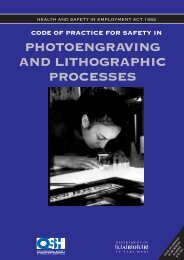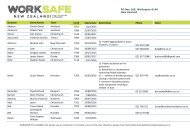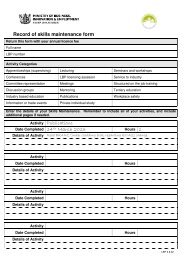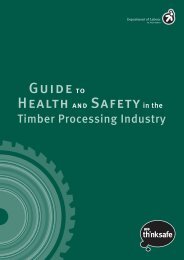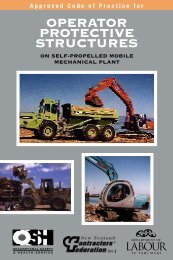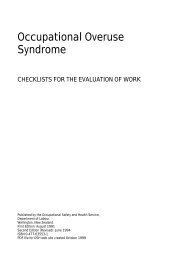The Epidemiology of Mesothelioma in Historical ... - Business.govt.nz
The Epidemiology of Mesothelioma in Historical ... - Business.govt.nz
The Epidemiology of Mesothelioma in Historical ... - Business.govt.nz
You also want an ePaper? Increase the reach of your titles
YUMPU automatically turns print PDFs into web optimized ePapers that Google loves.
occupational safety and health service<br />
THE EPIDEMIOLOGY OF<br />
MESOTHELIOMA IN HISTORICAL<br />
CONTEXT<br />
J.C. McDonald, A.D. McDonald<br />
OCCUPATIONAL SAFETY<br />
& HEALTH SERVICE<br />
DEPARTMENT OF<br />
LABOUR<br />
TE TARI MAHI<br />
1
Emeritus Pr<strong>of</strong>essor Corbett McDonald M.D. F.R.C.P.<br />
Pr<strong>of</strong>essor McDonald was born <strong>in</strong> Belfast <strong>in</strong> 1918 and<br />
graduated <strong>in</strong> medic<strong>in</strong>e from St. Mary’s Hospital, London,<br />
<strong>in</strong> 1942. After four years <strong>in</strong> the army, ma<strong>in</strong>ly <strong>in</strong> Italy, and<br />
after five years postgraduate tra<strong>in</strong><strong>in</strong>g <strong>in</strong> epidemiology at<br />
London and Harvard, he entered the British Public Health<br />
Laboratory Service, where he was Director <strong>of</strong><br />
epidemiological research with special <strong>in</strong>terest <strong>in</strong> respiratory<br />
virus <strong>in</strong>fections.<br />
In 1964 he was appo<strong>in</strong>ted to the Chair <strong>of</strong> a new<br />
Department <strong>of</strong> <strong>Epidemiology</strong> at McGill University,<br />
Montreal, and <strong>in</strong> 1976 moved back to direct the Institute<br />
<strong>of</strong> Occupational Health <strong>in</strong> London. In 1981, Pr<strong>of</strong>essor<br />
McDonald returned to McGill to establish a new School <strong>of</strong> Occupational Health<br />
but <strong>in</strong> 1986 he was <strong>in</strong>vited back to establish a new Department <strong>of</strong> Cl<strong>in</strong>ical<br />
<strong>Epidemiology</strong> at the Royal Brompton National Heart and Lung Institute. He<br />
cont<strong>in</strong>ues to work part-time <strong>in</strong> both cont<strong>in</strong>ents.<br />
Over the years his research has focused on respiratory disease, <strong>in</strong> particular<br />
the health effects <strong>of</strong> asbestos and crystall<strong>in</strong>e silica. He is Emeritus Pr<strong>of</strong>essor <strong>of</strong><br />
epidemiology at McGill University and <strong>of</strong> occupational medic<strong>in</strong>e <strong>in</strong> London. He<br />
is the author <strong>of</strong> some 250 scientific papers and has recently edited a comprehensive<br />
book entitled <strong>The</strong> <strong>Epidemiology</strong> <strong>of</strong> Occupational Diseases.<br />
Emeritus Pr<strong>of</strong>essor Alison McDonald M.D. F.F.C.M.<br />
Alison McDonald was born near London <strong>in</strong> 1917 and<br />
graduated <strong>in</strong> medic<strong>in</strong>e from the Royal Free Hospital<br />
Medical School, London, <strong>in</strong> 1941. After work<strong>in</strong>g <strong>in</strong><br />
general practice dur<strong>in</strong>g the war, she undertook<br />
postgraduate tra<strong>in</strong><strong>in</strong>g <strong>in</strong> epidemiology and public health at<br />
London and Harvard. Her pr<strong>in</strong>cipal appo<strong>in</strong>tments have<br />
been as Senior Lecturer <strong>in</strong> Pediatrics at Guys (1964-68),<br />
Pr<strong>of</strong>essor <strong>of</strong> <strong>Epidemiology</strong> at McGill (1964-78), Pr<strong>of</strong>essor<br />
<strong>of</strong> <strong>Epidemiology</strong> at St. Mary’s Hospital, London, (1978-<br />
81) and Emeritus Pr<strong>of</strong>essor, London, s<strong>in</strong>ce 1981. She<br />
returned to Montreal to head a Quebec government<br />
research team on the health effects <strong>of</strong> work <strong>in</strong> pregnancy<br />
(1981-1987).<br />
Dur<strong>in</strong>g the period 1952-64, her studies <strong>of</strong> very low birth weight children<br />
provided def<strong>in</strong>itive <strong>in</strong>formation on the <strong>in</strong>cidence <strong>of</strong> cerebral palsy and a wide range<br />
<strong>of</strong> development defects. Equally def<strong>in</strong>itive were the results <strong>of</strong> her enormous study<br />
<strong>of</strong> 100,000 pregnancies <strong>in</strong> Montreal, 1981-87, on the risks <strong>of</strong> occupational<br />
exposures <strong>in</strong> pregnancy.<br />
Her numerous studies <strong>of</strong> asbestos workers s<strong>in</strong>ce 1964 showed the large<br />
differences <strong>in</strong> risk <strong>of</strong> lung cancer and mesothelioma related to fibre type and<br />
<strong>in</strong>dustrial process. She was the first to demonstrate the role <strong>of</strong> fibrous tremolite <strong>in</strong><br />
these diseases, and recently that mesothelioma attributed to chrysotile is probably<br />
due to tremolite contam<strong>in</strong>ation.<br />
OCCUPATIONAL SAFETY<br />
& HEALTH SERVICE<br />
DEPARTMENT OF<br />
LABOUR<br />
TE TARI MAHI<br />
PUBLISHED BY THE OCCUPATIONAL SAFETY AND HEALTH SERVICE, DEPARTMENT OF LABOUR,<br />
WELLINGTON, NEW ZEALAND. JUNE 1998<br />
400/P386
Programme<br />
AUCKLAND, THURSDAY 29 JANUARY 1998<br />
1 Cl<strong>in</strong>ically based surveillance <strong>of</strong> occupational diseases <strong>in</strong> the United K<strong>in</strong>gdom.<br />
Auckland Hospital Medical Science Lecture, Auckland Hospital, Auckland.<br />
2 Surveillance systems for occupational disease and epidemiology <strong>of</strong> mesothelioma:<br />
historical and recent.<br />
A comb<strong>in</strong>ed meet<strong>in</strong>g <strong>of</strong> the Australasian Faculty <strong>of</strong> Occupational Medic<strong>in</strong>e and the<br />
Australasian Society <strong>of</strong> Occupational Medic<strong>in</strong>e, sponsored by the National Asbestos<br />
Medical Panel.<br />
Environmedix, 654 Manukau Rd, Auckland.
Contents<br />
McDonald J.C. and McDonald A.D. <strong>The</strong> epidemiology <strong>of</strong> mesothelioma<br />
<strong>in</strong> historical context. (Repr<strong>in</strong>ted with permission from <strong>The</strong> European<br />
Respiratory Journal 1996: 9, 1932-1942) ............................................................ Pages 3-14 *<br />
<strong>The</strong> New Zealand Asbestos Registers ...................................................................Pages 15-19<br />
* NOTE TO WEB SITE USERS<br />
Unfortunately, an electronic version <strong>of</strong> this paper is not available and could not be <strong>in</strong>cluded <strong>in</strong> this<br />
document . However, a pr<strong>in</strong>ted copy <strong>of</strong> the document is available from the Centre for National<br />
Support, Occupational Safety and Health Service.
<strong>The</strong> epidemiology <strong>of</strong> mesothelioma<br />
<strong>in</strong> historical context<br />
J.C.McDonald, A.D. McDonald<br />
THE<br />
EUROPEAN<br />
RESPIRATORY<br />
JOURNAL<br />
OFFICIAL JOURNAL OF THE<br />
EUROPEAN RESPIRATORY SOCIETY<br />
1996: 9,1932-1942
<strong>The</strong> New Zealand Asbestos Registers<br />
<strong>The</strong> National Asbestos Registers were established <strong>in</strong> March 1992 <strong>in</strong> l<strong>in</strong>e with the recommendations made to<br />
the M<strong>in</strong>ister <strong>of</strong> Labour, by the Asbestos Advisory Committee.<br />
Formation <strong>of</strong> the Asbestos Advisory Committee<br />
<strong>The</strong> Asbestos Advisory Committee was established <strong>in</strong> October 1990 as an ad hoc body to report to the<br />
M<strong>in</strong>ister <strong>of</strong> Labour on issues relat<strong>in</strong>g to the health effects and use <strong>of</strong> asbestos <strong>in</strong> New Zealand, adequacy <strong>of</strong><br />
controls and legislation, and clarification <strong>of</strong> the legal entitlements available for affected workers. This followed<br />
<strong>in</strong>creas<strong>in</strong>g public concern about the past and present effects <strong>of</strong> asbestos on workers, former workers and their<br />
families.<br />
Establishment <strong>of</strong> the National Asbestos Registers<br />
Recommendation 4 <strong>of</strong> the Report <strong>of</strong> the Asbestos Advisory Committee 1 to the M<strong>in</strong>ister <strong>of</strong> Labour advised:<br />
That an asbestos medical register be established for people who have been significantly exposed to asbestos.<br />
OSH should be the organisation responsible for establish<strong>in</strong>g, ma<strong>in</strong>ta<strong>in</strong><strong>in</strong>g and fund<strong>in</strong>g the medical register.<br />
<strong>The</strong> medical register should be <strong>in</strong> two parts:<br />
Part 1 - Those notified as hav<strong>in</strong>g been exposed to asbestos;<br />
Part 2 - Those notified as hav<strong>in</strong>g an asbestos-related disease.<br />
<strong>The</strong> system should allow movement <strong>of</strong> the name <strong>of</strong> a registered person from part 1 to part 2 <strong>of</strong> the register<br />
when <strong>in</strong>dicated.<br />
Notifications to part 1 <strong>of</strong> the medical register were to be made by those who felt that they had been exposed to<br />
asbestos, or by people act<strong>in</strong>g on their behalf (and follow<strong>in</strong>g consultation) such as an employer, union <strong>of</strong>ficial, relative<br />
or friend.<br />
Notification to part 2 <strong>of</strong> the medical register would be done by medical practitioners.<br />
A Notifiable Occupational Disease System (NODS) was established <strong>in</strong> 1992 and asbestos registers have<br />
been <strong>in</strong>corporated <strong>in</strong> that scheme. This was <strong>in</strong> accordance with recommendation 5 <strong>of</strong> the Asbestos Advisory<br />
Committee.<br />
THE ASBESTOS EXPOSURE REGISTER<br />
<strong>The</strong> Occupational Safety and Health Service <strong>of</strong> the Department <strong>of</strong> Labour (OSH), <strong>in</strong> association with<br />
Electricorp Production, undertook an extensive advertis<strong>in</strong>g campaign <strong>in</strong> March and April 1992.<br />
Advertisements were published <strong>in</strong> all <strong>of</strong> the major newspapers, and several trade magaz<strong>in</strong>es.<br />
<strong>The</strong> <strong>in</strong>terest generated as a result <strong>of</strong> this campaign has ensured a high response rate for the exposure<br />
register. Notifications have been made by <strong>in</strong>dividuals, trade unions, occupational health nurses, doctors, the<br />
Asbestos Diseases Association <strong>of</strong> New Zealand and by some larger companies.<br />
Notifications are directed either to branch <strong>of</strong>fices <strong>of</strong> OSH or directly to the Registrar.<br />
In recommendation 4, the committee had envisaged that people wish<strong>in</strong>g to be recorded on the asbestos<br />
exposure register would have their exposure assessed at an OSH branch. Only those people who were judged<br />
as hav<strong>in</strong>g had “significant exposure” would then be recorded on this register. However, the huge response from<br />
those <strong>in</strong>dividuals who had been exposed made it impractical to screen registrants <strong>in</strong> this fashion.<br />
Once a person has notified OSH that they have been exposed to asbestos, an asbestos exposure<br />
registration form is sent. <strong>The</strong> registration form collects <strong>in</strong>formation about the <strong>in</strong>dividual, their work exposure<br />
15
to asbestos and the state <strong>of</strong> their respiratory health.<br />
When the form has been completed and returned to the Registrar, the details are recorded on a database.<br />
<strong>The</strong> <strong>in</strong>dividual is then sent a copy <strong>of</strong> a special edition <strong>of</strong> the magaz<strong>in</strong>e Safeguard, which is dedicated to<br />
asbestos and its associated health problems. If the person <strong>in</strong>dicates that they have a family doctor, the doctor is<br />
<strong>in</strong>formed that their patient has been <strong>in</strong>cluded on the asbestos exposure register, and is sent a copy <strong>of</strong> OSH’s<br />
booklet Asbestos Exposure and Disease: Notes for Medical Practitioners.<br />
<strong>The</strong> register provides a database <strong>of</strong> the numbers <strong>of</strong> people exposed to asbestos through their occupation<br />
<strong>in</strong> New Zealand. OSH is provid<strong>in</strong>g <strong>in</strong>formation to the people recorded on this register and to their doctors.<br />
Through the operation <strong>of</strong> this register, OSH is hop<strong>in</strong>g to raise the awareness <strong>of</strong> the possible health effects <strong>of</strong><br />
asbestos exposure among the general public and the medical pr<strong>of</strong>ession.<br />
THE ASBESTOS DISEASE REGISTER<br />
A register for those people notified to OSH as hav<strong>in</strong>g an asbestos-related disease was also established and is<br />
operated under the auspices <strong>of</strong> the National Asbestos Medical Panel.<br />
<strong>The</strong> establishment <strong>of</strong> both this register and the panel has been carried out <strong>in</strong> accordance with<br />
recommendations 4, 5, 6 and 7 <strong>of</strong> the Asbestos Advisory Committee’s Report to the M<strong>in</strong>ister <strong>of</strong> Labour.<br />
Tenders for the National Asbestos Medical Panel were called for <strong>in</strong> 1991. A tender was accepted on 31<br />
October 1991. <strong>The</strong> successful tender came from the group listed below:<br />
W. Glass MBChB DIH FFOM FAFOM FAFOM (Hon) FFOM(Hon) (Convenor)<br />
R. Armstrong MBChB (Hons) FRCP FRACP<br />
*R. Beasley MBChB FRACP DM<br />
*J. Crane MBBS FRACP<br />
D. Jones MBBS MRCP FRACP<br />
N. Pearce BSc PhD (<strong>Epidemiology</strong>)<br />
*Dr Beasley has s<strong>in</strong>ce retired upon his appo<strong>in</strong>tment as Pr<strong>of</strong>essor <strong>of</strong> Medic<strong>in</strong>e at the Well<strong>in</strong>gton Cl<strong>in</strong>ical School. Dr<br />
Crane jo<strong>in</strong>ed the National Occupational Asthma Panel.<br />
Pr<strong>of</strong>essor Glass was nom<strong>in</strong>ated as the panel’s convenor.<br />
<strong>The</strong> follow<strong>in</strong>g members were appo<strong>in</strong>ted to the National Asbestos Radiological Panel:<br />
Dr Paul White<br />
Dr George Foote<br />
*Dr Graeme Anderson<br />
*Dr Anderson has s<strong>in</strong>ce retired.<br />
<strong>The</strong> Registrar from 1991 to 1996 was Mr Craig Eades. S<strong>in</strong>ce 1996, it has been Ms Nicola Holden.<br />
<strong>The</strong> National Asbestos Medical Panel is responsible for verify<strong>in</strong>g all cases <strong>of</strong> asbestos-related disease.<br />
Once a case has been verified by the panel, the personal and medical details <strong>of</strong> the <strong>in</strong>dividual are recorded on a<br />
database. <strong>The</strong> first meet<strong>in</strong>g <strong>of</strong> the panel was held <strong>in</strong> February 1992.<br />
All personal <strong>in</strong>formation is stored under conditions <strong>of</strong> strict confidentiality.<br />
Processes for Register<strong>in</strong>g People<br />
Notifications for the register come from two major sources. <strong>The</strong> first is from doctors whose patients have<br />
been diagnosed, or are suspected <strong>of</strong> hav<strong>in</strong>g, an asbestos-related disease. <strong>The</strong> second source <strong>of</strong> notification is<br />
16
from the <strong>in</strong>dividuals themselves.<br />
As this register has been <strong>in</strong>cluded as part <strong>of</strong> the Notifiable Occupational Disease System, most <strong>of</strong> the<br />
notifications from doctors have come on the NODS cards which have been distributed to doctors and<br />
occupational health nurses by OSH. Other notifications from doctors have come <strong>in</strong> the form <strong>of</strong> letters.<br />
Once a notification has been made to the Registrar, and consent has been ga<strong>in</strong>ed from the person<br />
concerned, relevant medical records and a full occupational history are obta<strong>in</strong>ed.<br />
Over the three years s<strong>in</strong>ce the register began, it has already become clear that it is serv<strong>in</strong>g many <strong>of</strong> the<br />
functions predicted. It has raised the awareness <strong>of</strong> asbestos-related diseases among patients and the health<br />
pr<strong>of</strong>essionals. It has improved the diagnosis <strong>of</strong> asbestos-related disease at all levels <strong>of</strong> pr<strong>of</strong>essional speciality.<br />
<strong>The</strong>re has developed a grow<strong>in</strong>g awareness by general practitioners, <strong>in</strong> particular, <strong>of</strong> work as an important<br />
determ<strong>in</strong>ant <strong>of</strong> disease. <strong>The</strong> result has been an upsurge <strong>in</strong> voluntary notifications <strong>of</strong> occupationally-related<br />
diseases generally to the National Registration Centre at the Occupational Safety and Health Service <strong>of</strong> the<br />
Department <strong>of</strong> Labour (OSH).<br />
DATA COLLECTION<br />
<strong>The</strong> data collected <strong>in</strong>cludes a medical history, an occupational history, chest x-ray, CT scan where available,<br />
lung function tests, and pathology reports. <strong>The</strong> procedure is as follows.<br />
On notification be<strong>in</strong>g received by the Registrar:<br />
(a) An occupational health nurse visits the patient and carries out a health <strong>in</strong>terview, a detailed<br />
occupational and social (<strong>in</strong>clud<strong>in</strong>g smok<strong>in</strong>g) history.<br />
(b) Relevant medical reports are obta<strong>in</strong>ed from general practitioners and physicians.<br />
(c) A recent PA chest x-ray is obta<strong>in</strong>ed, and <strong>in</strong> all cases is read by a radiologist accord<strong>in</strong>g to ILO (1980)<br />
guidel<strong>in</strong>es. CTs are used where available, and on occasions requested.<br />
(d) Lung function data are obta<strong>in</strong>ed from physicians’ reports or requested from respiratory laboratories.<br />
Where this is not possible, results are obta<strong>in</strong>ed from a test carried out by an occupational health nurse, us<strong>in</strong>g a<br />
portable spirometer.<br />
(e) Pathology and post-mortem reports are reviewed where available.<br />
DATA ASSESSMENT<br />
<strong>The</strong> National Asbestos Medical Panel reviews the <strong>in</strong>formation obta<strong>in</strong>ed, calculates an exposure <strong>in</strong>dex (see<br />
below) and correlates the medical data.<br />
(a) Exposure <strong>in</strong>dex<br />
An exposure <strong>in</strong>dex (D) is calculated from the product <strong>of</strong> years <strong>of</strong> asbestos exposure (A); <strong>in</strong>tensity <strong>of</strong> exposure<br />
(accord<strong>in</strong>g to job category), us<strong>in</strong>g a 1-5 grad<strong>in</strong>g (B); and frequency <strong>of</strong> exposure, us<strong>in</strong>g a 1-3 grad<strong>in</strong>g (C).<br />
Guidel<strong>in</strong>es for calculat<strong>in</strong>g this <strong>in</strong>dex are shown below.<br />
A =Total years <strong>of</strong> exposure <strong>in</strong> any one job.<br />
B = Job category as follows:<br />
M<strong>in</strong><strong>in</strong>g, mill<strong>in</strong>g and process<strong>in</strong>g = 5<br />
Boiler/lagg<strong>in</strong>g, rail carriages, shipyard, spray<strong>in</strong>g <strong>in</strong>sulation = 4<br />
Asbestos cement products, construction, demolition, removal = 3<br />
Electrical, friction products = 2<br />
Load<strong>in</strong>g, driv<strong>in</strong>g, environmental = 1<br />
C = Degree <strong>of</strong> exposure (unprotected):<br />
Cont<strong>in</strong>uous (>50% <strong>of</strong> work) = 5<br />
Intermittent (20-50% <strong>of</strong> work) = 2<br />
M<strong>in</strong>imal (
D = A x B x C for each job<br />
Exposure <strong>in</strong>dex = sum <strong>of</strong> all Ds<br />
(b) Medical data<br />
Relevant respiratory symptoms and signs are noted from the medical histories, and lung function data is<br />
classified <strong>in</strong>to restrictive, obstructive, mixed or normal. Pathology reports are used to confirm mesotheliomas<br />
and classify lung cancers.<br />
CLASSIFICATION OF DIAGNOSTIC CATEGORIES<br />
On the basis <strong>of</strong> the forego<strong>in</strong>g, the cases are placed <strong>in</strong>to a primary diagnostic category <strong>of</strong>:<br />
• <strong>Mesothelioma</strong><br />
• Lung cancer<br />
• Asbestosis<br />
• Pleural abnormalities (plaques, diffuse bilateral pleural thicken<strong>in</strong>g and effusions).<br />
• Other cancers<br />
• Obstructive lung disease without x-ray changes.<br />
SUMMARY OF REGISTRATIONS 1992-1997<br />
Registrations to the Asbestos Exposure Register number <strong>in</strong> excess <strong>of</strong> 13,000.<br />
Registrations to the Asbestos Disease Register number 554 cases and <strong>in</strong>clude 96 cases <strong>of</strong> mesothelioma,<br />
47 cases <strong>of</strong> lung cancer, 118 cases <strong>of</strong> asbestosis and 293 cases <strong>of</strong> pleural abnormalities. An analysis <strong>of</strong> those<br />
figures is provided <strong>in</strong> the 1996-97 Annual Report <strong>of</strong> the Asbestos Registers.<br />
APPENDIX: MEMBERS OF THE NATIONAL ASBESTOS MEDICAL PANEL<br />
W. Glass MBChB, DPH, DIH, FFOM, FAFOM, FAFOM(Hon.), FFOM(I) (Convenor)<br />
R. Armstrong MBChB (Hons), FRCP, FRACP<br />
D. Jones MBBS, MRCP (UK), FRACP<br />
N. Pearce BSc, PhD (<strong>Epidemiology</strong>)<br />
•<br />
D. Fishwick MD, MRCP<br />
* Resigned August 1996<br />
•<br />
Appo<strong>in</strong>ted UK adviser 1997<br />
18
OSH PUBLICATIONS ON ASBESTOS<br />
A Deadly Dust: 50 years <strong>of</strong> Asbestos Use <strong>in</strong> New Zealand. Repr<strong>in</strong>t from Safeguard magaz<strong>in</strong>e, December 1991.<br />
Safe Work on Asbestos-based Floor Cover<strong>in</strong>gs. Leaflet, 1991.<br />
Audit <strong>of</strong> Floor Sanders and Work Practices Involv<strong>in</strong>g Asbstos-backed V<strong>in</strong>yl Sheet<strong>in</strong>g <strong>in</strong> the Christchurch Area.<br />
Occasional Paper Series No. 4, 1992.<br />
Recent Advances <strong>in</strong> Asbestos-Related Disease. Becklake, Margaret, 1994.<br />
Asbestos Exposure and Disease: Notes for Medical Practitioners. Booklet, 1995.<br />
Guidel<strong>in</strong>es for the Management and Removal <strong>of</strong> Asbestos. Booklet, 1995.<br />
Respiratory Symptoms and Asbestos Dust Exposure. Glass W., Fishwick D., Eades C., Pearce N., Armstrong L.<br />
and Jones D. Ocupational Health Report Series, No.2, 1997.<br />
Annual Reports <strong>of</strong> the National Asbestos Registers. 1992-1996/97.<br />
19


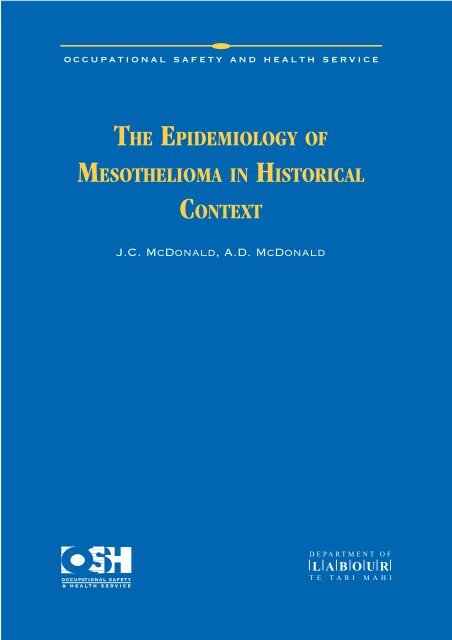

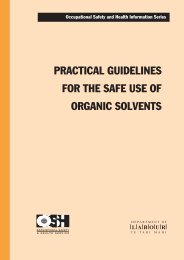
![Task analysis worksheet [161 KB PDF] - Business.govt.nz](https://img.yumpu.com/51400981/1/190x135/task-analysis-worksheet-161-kb-pdf-businessgovtnz.jpg?quality=85)

